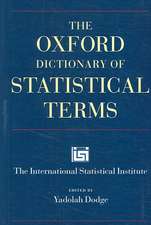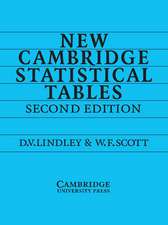Regression Modeling Strategies: With Applications to Linear Models, Logistic and Ordinal Regression, and Survival Analysis: Springer Series in Statistics
Autor Frank E. Harrell , Jr.en Limba Engleză Hardback – 26 aug 2015
Regression Modelling Strategies presents full-scale case studies of non-trivial data-sets instead of over-simplified illustrations of each method. These case studies use freely available R functions that make the multiple imputation, model building, validation and interpretation tasks described in the book relatively easy to do. Most of the methods in this text apply to all regression models, but special emphasis is given to multiple regression using generalised least squares for longitudinal data, the binary logistic model, models for ordinal responses, parametric survival regression models and the Cox semi parametric survival model. A new emphasis is given to the robust analysis of continuous dependent variables using ordinal regression.
As in the first edition, this text is intended for Masters' or PhD. level graduate students who have had a general introductory probability and statistics course and who are well versed in ordinary multiple regression and intermediate algebra. The book will also serve as a reference for data analysts and statistical methodologists, as it contains an up-to-date survey and bibliography of modern statistical modelling techniques.
| Toate formatele și edițiile | Preț | Express |
|---|---|---|
| Paperback (1) | 521.83 lei 43-57 zile | |
| Springer International Publishing – 22 oct 2016 | 521.83 lei 43-57 zile | |
| Hardback (1) | 679.60 lei 22-36 zile | +52.34 lei 6-12 zile |
| Springer International Publishing – 26 aug 2015 | 679.60 lei 22-36 zile | +52.34 lei 6-12 zile |
Din seria Springer Series in Statistics
- 20%
 Preț: 630.98 lei
Preț: 630.98 lei - 20%
 Preț: 816.45 lei
Preț: 816.45 lei - 20%
 Preț: 1000.85 lei
Preț: 1000.85 lei -
 Preț: 390.84 lei
Preț: 390.84 lei - 20%
 Preț: 697.14 lei
Preț: 697.14 lei - 20%
 Preț: 445.20 lei
Preț: 445.20 lei - 20%
 Preț: 884.71 lei
Preț: 884.71 lei - 18%
 Preț: 1237.14 lei
Preț: 1237.14 lei - 18%
 Preț: 961.82 lei
Preț: 961.82 lei - 18%
 Preț: 956.50 lei
Preț: 956.50 lei - 18%
 Preț: 794.25 lei
Preț: 794.25 lei - 15%
 Preț: 648.05 lei
Preț: 648.05 lei - 18%
 Preț: 1217.10 lei
Preț: 1217.10 lei - 15%
 Preț: 646.11 lei
Preț: 646.11 lei - 15%
 Preț: 647.08 lei
Preț: 647.08 lei - 15%
 Preț: 646.11 lei
Preț: 646.11 lei - 18%
 Preț: 1329.76 lei
Preț: 1329.76 lei - 15%
 Preț: 652.81 lei
Preț: 652.81 lei - 18%
 Preț: 1114.52 lei
Preț: 1114.52 lei - 18%
 Preț: 952.40 lei
Preț: 952.40 lei - 18%
 Preț: 1333.42 lei
Preț: 1333.42 lei - 18%
 Preț: 1561.68 lei
Preț: 1561.68 lei - 18%
 Preț: 1231.47 lei
Preț: 1231.47 lei - 15%
 Preț: 513.64 lei
Preț: 513.64 lei - 18%
 Preț: 893.71 lei
Preț: 893.71 lei - 15%
 Preț: 649.87 lei
Preț: 649.87 lei - 18%
 Preț: 1007.65 lei
Preț: 1007.65 lei - 18%
 Preț: 1111.67 lei
Preț: 1111.67 lei - 18%
 Preț: 1223.70 lei
Preț: 1223.70 lei - 18%
 Preț: 892.74 lei
Preț: 892.74 lei - 18%
 Preț: 913.26 lei
Preț: 913.26 lei - 18%
 Preț: 943.88 lei
Preț: 943.88 lei -
 Preț: 391.61 lei
Preț: 391.61 lei -
 Preț: 391.22 lei
Preț: 391.22 lei - 18%
 Preț: 1331.18 lei
Preț: 1331.18 lei -
 Preț: 390.84 lei
Preț: 390.84 lei - 18%
 Preț: 888.45 lei
Preț: 888.45 lei - 18%
 Preț: 960.61 lei
Preț: 960.61 lei - 18%
 Preț: 1245.34 lei
Preț: 1245.34 lei - 18%
 Preț: 964.54 lei
Preț: 964.54 lei - 15%
 Preț: 643.16 lei
Preț: 643.16 lei - 18%
 Preț: 1723.76 lei
Preț: 1723.76 lei - 15%
 Preț: 643.84 lei
Preț: 643.84 lei - 15%
 Preț: 586.37 lei
Preț: 586.37 lei - 18%
 Preț: 999.59 lei
Preț: 999.59 lei - 15%
 Preț: 643.34 lei
Preț: 643.34 lei - 18%
 Preț: 806.40 lei
Preț: 806.40 lei - 18%
 Preț: 727.66 lei
Preț: 727.66 lei
Preț: 679.60 lei
Preț vechi: 790.24 lei
-14% Nou
Puncte Express: 1019
Preț estimativ în valută:
130.06€ • 135.28$ • 107.37£
130.06€ • 135.28$ • 107.37£
Carte disponibilă
Livrare economică 24 martie-07 aprilie
Livrare express 08-14 martie pentru 62.33 lei
Preluare comenzi: 021 569.72.76
Specificații
ISBN-13: 9783319194240
ISBN-10: 3319194240
Pagini: 582
Ilustrații: XXV, 582 p. 157 illus., 53 illus. in color.
Dimensiuni: 178 x 254 x 40 mm
Greutate: 1.27 kg
Ediția:2nd ed. 2015
Editura: Springer International Publishing
Colecția Springer
Seria Springer Series in Statistics
Locul publicării:Cham, Switzerland
ISBN-10: 3319194240
Pagini: 582
Ilustrații: XXV, 582 p. 157 illus., 53 illus. in color.
Dimensiuni: 178 x 254 x 40 mm
Greutate: 1.27 kg
Ediția:2nd ed. 2015
Editura: Springer International Publishing
Colecția Springer
Seria Springer Series in Statistics
Locul publicării:Cham, Switzerland
Public țintă
GraduateCuprins
Introduction.- General Aspects of Fitting Regression Models.- Missing Data.- Multivariable Modeling Strategies.- Describing, Resampling, Validating and Simplifying the Model.- R Software.- Modeling Longitudinal Responses using Generalized Least Squares.- Case Study in Data Reduction.- Overview of Maximum Likelihood Estimation.- Binary Logistic Regression.- Binary Logistic Regression Case Study 1.- Logistic Model Case Study 2: Survival of Titanic Passengers.- Ordinal Logistic Regression.- Case Study in Ordinal Regression, Data Reduction and Penalization.- Regression Models for Continuous Y and Case Study in Ordinal Regression.- Transform-Both-Sides Regression.- Introduction to Survival Analysis.- Parametric Survival Models.- Case Study in Parametric Survival Modeling and Model Approximation.- Cox Proportional Hazards Regression Model.- Case Study in Cox Regression.- Appendix.
Recenzii
“The aim and scope of this edition to provide graduate students and professional and early career researchers with insights, understandings and working knowledge of regression modelling. … . The book is sequentially organized and well structured and many chapters are self-contained. It includes many useful topics and techniques for graduate .students and researchers alike. This book can be used as a textbook and equally as a reference book.” (Technometrics, Vol. 58 (2), February, 2016)
Notă biografică
Frank E. Harrell, Jr. is Professor of Biostatistics and Chair, Department of Biostatistics, Vanderbilt University School of Medicine, Nashville. He has developed numerous methods for predictive modeling, quantifying predictive accuracy and model validation and has published numerous predictive models and articles on applied statistics, medical research and clinical trials. He is on the editorial board for several biomedical and methodologic journals. He is a Fellow of the American Statistical Association (ASA) and a consultant to the U.S. Food and Drug Administration and to the pharmaceutical industry. He teaches a graduate course in regression modeling strategies and a course in biostatistics for medical researchers. In 2014 he was chosen to receive the WJ Dixon Award for Excellence in Statistical Consulting by the ASA.
Textul de pe ultima copertă
This highly anticipated second edition features new chapters and sections, 225 new references, and comprehensive R software. In keeping with the previous edition, this book is about the art and science of data analysis and predictive modeling, which entails choosing and using multiple tools. Instead of presenting isolated techniques, this text emphasizes problem solving strategies that address the many issues arising when developing multivariable models using real data and not standard textbook examples. It includes imputation methods for dealing with missing data effectively, methods for fitting nonlinear relationships and for making the estimation of transformations a formal part of the modeling process, methods for dealing with "too many variables to analyze and not enough observations," and powerful model validation techniques based on the bootstrap. The reader will gain a keen understanding of predictive accuracy, and the harm of categorizing continuous predictors or outcomes. This text realistically deals with model uncertainty, and its effects on inference, to achieve "safe data mining." It also presents many graphical methods for communicating complex regression models to non-statisticians.
Regression Modeling Strategies presents full-scale case studies of non-trivial datasets instead of over-simplified illustrations of each method. These case studies use freely available R functions that make the multiple imputation, model building, validation, and interpretation tasks described in the book relatively easy to do. Most of the methods in this text apply to all regression models, but special emphasis is given to multiple regression using generalized least squares for longitudinal data, the binary logistic model, models for ordinal responses, parametric survival regression models, and the Cox semiparametric survival model. A new emphasis is given to the robust analysis of continuous dependent variables using ordinal regression.
As in
the first edition, this text is intended for Masters' or Ph.D. level graduate students who have had a general introductory probability and statistics course and who are well versed in ordinary multiple regression and intermediate algebra. The book will also serve as a reference for data analysts and statistical methodologists, as it contains an up-to-date survey and bibliography of modern statistical modeling techniques. Examples used in the text mostly come from biomedical research, but the methods are applicable anywhere predictive models ("analytics") are useful, including economics, epidemiology, sociology, psychology, engineering, and marketing.
Regression Modeling Strategies presents full-scale case studies of non-trivial datasets instead of over-simplified illustrations of each method. These case studies use freely available R functions that make the multiple imputation, model building, validation, and interpretation tasks described in the book relatively easy to do. Most of the methods in this text apply to all regression models, but special emphasis is given to multiple regression using generalized least squares for longitudinal data, the binary logistic model, models for ordinal responses, parametric survival regression models, and the Cox semiparametric survival model. A new emphasis is given to the robust analysis of continuous dependent variables using ordinal regression.
As in
the first edition, this text is intended for Masters' or Ph.D. level graduate students who have had a general introductory probability and statistics course and who are well versed in ordinary multiple regression and intermediate algebra. The book will also serve as a reference for data analysts and statistical methodologists, as it contains an up-to-date survey and bibliography of modern statistical modeling techniques. Examples used in the text mostly come from biomedical research, but the methods are applicable anywhere predictive models ("analytics") are useful, including economics, epidemiology, sociology, psychology, engineering, and marketing.
Caracteristici
Fully revised new edition features new material and color figures Published with mature, supplementary R package: rms New chapters and sections on generalized least squares for analysis of serial response data, redundancy analysis, bootstrap confidence intervals for rankings of predictors, expanded material on multiple imputation and predictive mean matching and more Includes supplementary material: sn.pub/extras














